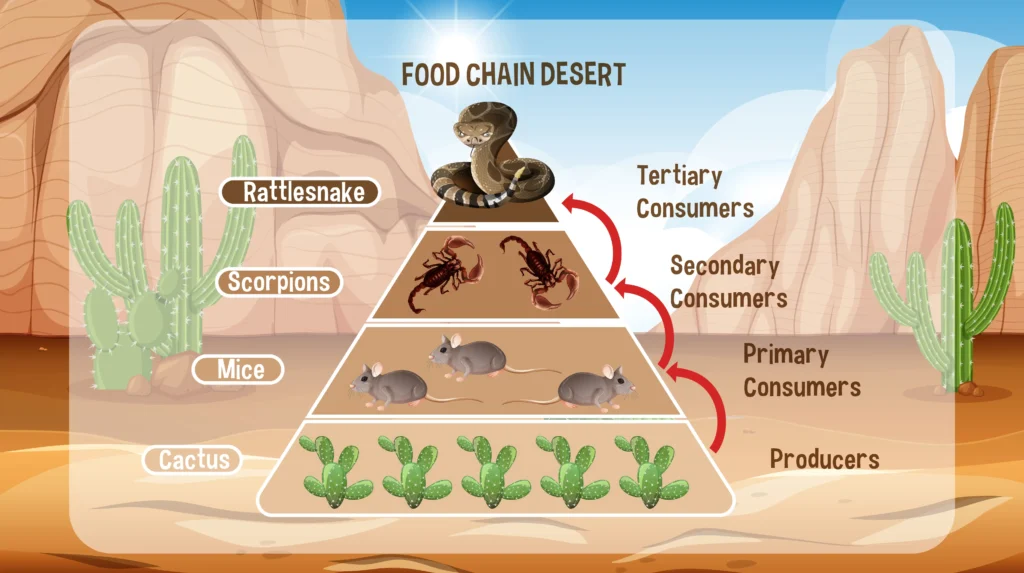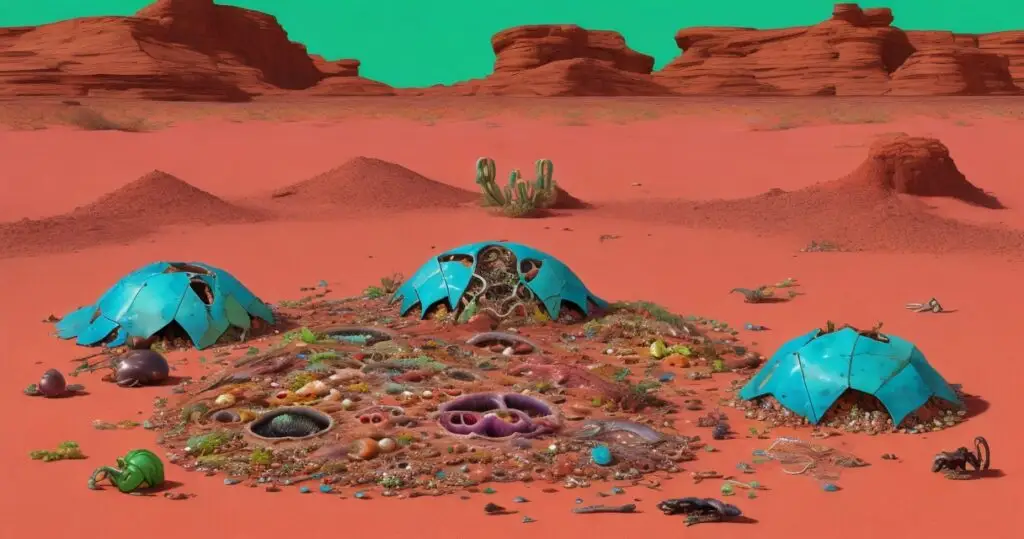The desert is one of the most barren biomes on Earth. The desert may appear devoid of life with the scorching heat, scarce water, and limited vegetation. The desert food chain and food web show how organisms adapt to survive and thrive in this extreme environment.
The desert food chain shows how plants and animals rely on each other in dry places, like cacti and coyotes. This article will provide an in-depth look at the various trophic levels of the fascinating, intricate desert ecosystem.

Southwestern deserts’ food chains function the same as those of forests, grassy plains, swamplands, and other ecosystems.
Biologists use the terms Food Chain or Food Web to refer to the series of living organisms through which energy flows to boost the lives of plants and animals. A food chain always begins with producers or plants. Animals, which are called consumers, are always at the end.
- What Is a Food Chain?
- Producers – The Foundation of the Desert Food Chain
- Primary Consumers – Herbivores Adapted to the Desert
- Secondary Consumers – Omnivores of the Desert
- Tertiary Consumers – The Predators
- Apex Predators – Kings of the Desert
- Decomposers – Recyclers of the Desert
- Desert Food Web
- Threats to the Desert Food Chain
- FAQs – Desert Food Chain and Food Web
- What are the different levels of the desert food chain?
- How do desert plants adapt to the harsh conditions?
- What animals are best adapted to live in the desert?
- What role do decomposers play in the desert food chain?
- How does climate change threaten desert food chains?
- Why is the desert food web so interconnected?
- References – Desert Food Chain and Food Web
What Is a Food Chain?
The food chain begins with a green plant and represents energy transfer from one living organism to the next.
A food chain is a graphical illustration showing energy transfer between organisms. Because energy is transmitted through food, a food chain illustrates which organisms in an ecosystem consume which others.
The levels of the food chain are known as trophic levels. At the bottom are producers, primary and secondary consumers, and tertiary consumers.
Producers – The Foundation of the Desert Food Chain
All food chains start with producers, organisms that can make their food. Photosynthetic plants, non-photosynthetic bacteria, and fungi form the producer base in the desert food chain.
Photosynthetic Plants
Desert plants like cacti, yucca, brittlebush, creosote bush, and agave have adapted through evolutionary processes to survive the desert climate. Their leaves have transformed into spines or scales to reduce water loss. Numerous plants in the desert conserve water within their succulent stems, roots, or foliage. These physiological adaptations allow photosynthetic desert plants to produce food and oxygen even in the driest conditions.
Non-Photosynthetic Bacteria and Fungi
In addition to green plants, non-photosynthetic producers play a crucial foundational role in the desert food chain. Nitrogen-fixing bacteria convert atmospheric nitrogen into ammonia, making vital nutrients available in desert soil.
Mycorrhizal fungi form symbiotic relationships with plant roots, improving scarce water and mineral uptake. Other fungi and bacteria act as decomposers, breaking down dead organic material. These non-photosynthetic producers fuel the desert ecosystem.
Primary Consumers – Herbivores Adapted to the Desert
Primary consumers are herbivores that feed on producers. The desert hosts a variety of specialized primary consumers that obtain moisture from the plants they eat.
Desert Insects
Many insects like ants, grasshoppers, and termites have adapted to derive water from the plants they consume. Desert locusts can eat their weight in vegetation daily.
Desert Rodents
Rodents like kangaroo rats and packrats survive on seeds, leaves, and stems of desert vegetation. Kangaroo rats get all the water they need from the plants they eat.
Desert Reptiles
Desert tortoises thrive on grasses and cacti. Their slow metabolism requires little water intake. Certain petite desert-dwelling reptiles like horned lizards derive hydration from consuming ants.
Desert Birds
Birds that consume seeds, such as sparrows and finches, depend on plants found in the desert. Cactus wrens and verdins build nests in cacti for protection.
Desert Mammals
Primary consumers in the desert, like camels, mountain sheep, and pronghorn antelopes, survive without water by eating juicy desert plants.
These herbivores form the next tier of the desert food chain. Carnivores prey on these primary consumers for energy.

Secondary Consumers – Omnivores of the Desert
Secondary consumers consist of omnivorous desert dwellers who eat plant and animal matter. These generalist feeders provide a vital link in the desert food chain.
Arachnids
Arachnids such as spiders, scorpions, vinegaroons, and sun spiders consume insects, lizards, and vegetation when prey is scarce.
Reptiles
Snakes like the gopher snake eat small mammals and eggs and consume plant material. Desert monitor lizards eat different foods depending on what is available, showing their opportunistic feeding behavior.

Birds
Roadrunners are primarily carnivorous, feeding on lizards, snakes, scorpions, and insects. But they supplement their diet with berries and seeds.
Mammals
Coyotes, foxes, and badgers are adaptable to desert omnivores. Depending on availability, coyotes may hunt smaller mammals and reptiles or scavenge fruit and plant material.
Secondary consumers in the desert can eat anything for energy due to their flexible eating habits.
Tertiary Consumers – The Predators
Moving up the food chain, tertiary consumers are the true carnivores of the desert ecosystem. These predators hunt and devour primary and secondary consumers.
Reptiles
Venomous snakes like rattlesnakes and Gila monsters overpower small mammal prey like rodents, rabbits, and hares. Non-venomous coachwhip snakes use speed and powerful jaws to eat reptiles and mammals.
Birds
Falcons, hawks, and eagles are formidable raptors that prey on smaller birds, reptiles, and rodents. Owls ambush mammals, birds, and insects under the cover of night.
Mammals
Foxes and bobcats prey on rabbits, birds, lizards, and snakes. On the other hand, ringtails consume a diet of mice, insects, birds, eggs, and fruit. Weasels and skunks also fill the tertiary consumer niche in the desert food web.
These deadly hunters keep prey species from overpopulating the desert ecosystem. But even the tertiary consumers must watch their backs for the apex predators lurking at the top of the food chain.

Apex Predators – Kings of the Desert
Apex predators sit atop the food chain without natural predators of their own. They are vital in maintaining ecological balance by weeding out older, weaker prey.
Reptiles
The Gila monster’s venomous bite provides it defense against most would-be predators. Its bright warning coloration leaves it unchallenged as an apex reptile.
Birds
Golden eagles are swift and powerful enough to take down fleet-footed jackrabbits. Their massive six-foot wingspan steals the apex avian spot.
Mammals
Besides humans, the primary apex mammal is the coyote. Their ability to hunt alone or in packs makes them a dominant predator. Gray wolves passing through the desert also assume the apex role.
Humans are the most dangerous apex predators due to tool use and advanced hunting techniques. But even humans must contend with the extremity of the desert environment.
Decomposers – Recyclers of the Desert
After death, decomposers break down organisms, which release nutrients into the desert soil or food web.

Fungi
Mushrooms, molds, and yeasts decompose dead plant and animal matter. Fungi keep the desert free from littered carcasses and waste.
Bacteria
Decay bacteria return nutrients from dead plants and animals to the soil and air. Nitrogen-fixing bacteria replenish nitrogen to support plant growth.
Invertebrates
Insects like burying beetles and fly larvae aid decay. Earthworms enrich the soil with nutrients. Ants and termites break down dead wood and leaf litter.
These decomposers form the recycling team of the desert, enabling them to reuse resources in the challenging environment constantly.
Desert Food Web
While the food chain shows linear energy flow, the desert food web illustrates the intricate interconnectedness of the desert biome. For instance, roadrunners may eat lizards or insects, which have eaten plants and smaller animals.
Hawks could prey on snakes, rodents, or rabbits. Coyotes might scavenge a rabbit killed by a fox. And decomposers eventually recycle all organic matter back into the web.
This complex mesh reveals how organisms depend on each other for energy transfer and nutrients. It also demonstrates the flexibility that allows desert species to utilize available resources. There are no isolated species in the desert food web.

Threats to the Desert Food Chain
While desert organisms have adapted for survival, human activity has increasingly pressured desert food chains.
Climate Change
Rising temperatures and vaporized water cycles threaten to overstress even hardy desert plants and animals. Entire food chains are at risk of collapse.
Habitat Loss
Urbanization, agriculture, and mining destroy native desert habitats. Fragmented landscapes disrupt animal movement and plant pollination.
Invasive Species
Invasive plants like buffelgrass and fountain grass outcompete native vegetation used by endemic wildlife. Invasive bullfrogs and crayfish prey on rare desert species.
Overgrazing
Too much cattle grazing can deplete the desert plant base other organisms depend on, degrading the food web.
Human Activity
Pollution, roads, fencing, and recreation disrupt and degrade delicately balanced desert ecosystems. Humans must be thoughtful stewards of these fragile environments.
With mindfulness of our impacts, humans can help conserve the desert biome and its incredible web of life.
FAQs – Desert Food Chain and Food Web
What are the different levels of the desert food chain?
The levels of the desert food chain include:
Producers like cacti and shrubs make their food through photosynthesis.
Primary consumers such as insects, rodents, and deer eat producers.
Secondary consumers like lizards, snakes, and coyotes that eat primary consumers.
Tertiary consumers eat secondary consumers, including hawks, foxes, and bobcats.
Apex predators like golden eagles and Gila monsters are at the top of the food chain.
Decomposers such as fungi and bacteria that break down dead organic matter.
How do desert plants adapt to the harsh conditions?
Desert plants adapt by having thick cuticles, reduced leaves, camouflaged colouring, water storage in stems or fleshy leaves, deep roots, nocturnal stomata opening, and growing during brief wet periods. These adaptations allow plants to minimize water loss.
What animals are best adapted to live in the desert?
Some well-adapted desert animals include camels, roadrunners, kangaroo rats, desert tortoises, kit foxes, addax antelope, fringe-toed lizards, oryx, sidewinder rattlesnakes, and desert iguanas. Adaptations like concentrated urine, nocturnal behaviour, burrowing, and heat tolerance enable them to minimize water loss and beat the desert heat.
What role do decomposers play in the desert food chain?
Decomposers like fungi, bacteria, and insects break down dead plant and animal matter, releasing nutrients into the soil and atmosphere. This recycling allows essential nutrients to be reused by living organisms in an ecosystem with minimal resources.
How does climate change threaten desert food chains?
Climate change can alter temperature, precipitation patterns, and desert water availability. This stresses plants and animals already living at the limits of their physiological tolerance and can cause population declines, loss of biodiversity, and collapse of food chains dependent on vulnerable species.
Why is the desert food web so interconnected?
The harsh desert conditions mean living things must utilize available resources to survive. Organisms like coyotes often eat foods like mammals, reptiles, insects, seeds, and fruit to use whatever nutrients they can find. This leads to a highly complex, interconnected food web.
References – Desert Food Chain and Food Web
- http://npshistory.com/brochures/whsa/desert-biome-food-chain-2015.pdf
- https://www.exploringnature.org/db/view/Desert-Food-Web-Mini-Poster
- https://sciencestruck.com/desert-food-chain
- https://www.slideserve.com/cheung/desert
